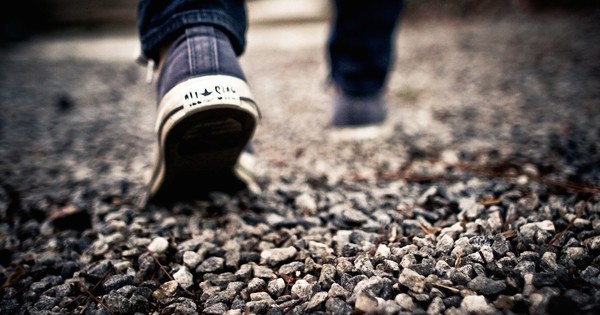10 ways to get the most from walking

No gym required: From frequency and stride to what to do with your arms, here’s how to get the world’s easiest fitness fix.
Unlike so many other forms of exercise, walking is not about gear or clothes or expertise. It does not require a gym, and it’s easy, cheap, and exceedingly kind to the body. Walking for the sake of taking a walk is emotionally as well as physically pleasing; walking for the sake of getting somewhere is cheaper and easier on the planet than driving. And for whatever reason you find yourself walking, it’s a great form of exercise. Walking is a wealth of wins.
With the CDC recommending 150 minutes of moderate-intensity aerobic activity a week, walking is a wonderful way to fulfill the quota. The University of California, Berkeley (UCB) has a good list of tips for maximizing a walking workout, from which I’ve expanded upon here.
1. A walk a day
UCB says to aim for brisk walking at least 30 minutes everyday; but if it’s better for your schedule, shoot for an hour-long walk four times a week. For a person weighing 150 pounds, walking 3.5 miles in an hour on a flat surface burns about 300 calories. Very (very) roughly, you can expect to burn somewhere around 100 calories per mile. But all of this said, walking as much as you can get in, even if it’s just a bit, is better than nothing.
2. Track it
A basic pedometer, fitness tracking device, or pedometer smartphone app will show you how many steps you take each day. UCB says to initially aim for a minimum at of 5,000 steps a day, working up to 10,000 steps: “In addition to walking at home and at work, incorporating some brisk walking into your daily routine can help you achieve the higher goals.” Also, keeping track of statistics works as a great motivation tool.
3. Remember the little steps
Forgo elevators and escalators; learn to love the stairs. Walk away from the car, when you can, and walk your errands and short trips. When driving, park a bit farther away and force yourself to walk the extra bit. If you use public transportation, walk to the next stop before hopping on. To pick up speed, take faster steps rather than longer ones; extending your stride can add stress to your legs and feet.
4. Get those arms swinging
You know how speed walkers have that classic arm-swing? There’s a reason; vigorous arm pumping allows for a quicker pace, and provides a good workout for your upper body, notes UCB: “Bend them at 90 degrees and pump from the shoulder. Move your arms in opposition to your legs – swing your right arm forward as you step forward with your left leg. Keep your wrists straight, your hands unclenched and your elbows close to your sides.”
5. Switch it up
Runners know the trick of changing the pace during interval training runs, it’s a boon for walkers too. Try quickening the pace for a minute or two out of every five minutes; or try, for example, walking one quicker mile with two slower ones. You can vary walking surfaces as well; while walking on a track is easy and gentle, walking on grass or gravel burns more calories. Walking on soft sand, according to UCB, increases caloric expenditure by almost 50 percent.
6. Embrace inclines
If you have hills nearby, head for them! Adding in some hills to a flat walk is a great way to add another way of interval training into your exercise. When taking hills, lean forward a bit to ease strain on your legs. Going down hills employs different muscles and may lead to soreness, and can be a little rougher on the knees – so slow down the pace, keep knees slightly bent, and decrease your stride.
7. Empower with walking poles
I’ve never understood walking poles, but upon learning that the lightweight, rubber-tipped trekking poles work to enhance an upper-body workout, it all makes sense now. UCB explains: “This is like cross-country skiing without the skis. It works the muscles of your chest, arms and abs, while reducing knee stress.” They recommend testing poles in a store before buying them, noting that you should be able to grip each pole and keep your forearm about level as you walk.
8. Handle hand weights with caution
Hand weights can help burn more calories and add to the upper-body workout – but they can make your arm swing wonky and lead to soreness or injury if not used properly. Start gradually with one-pound weights and bump up the weight slowly, never using weights heavier than 10 percent of your body weight. Ankle weights are not recommended as they can lead to injury, says UCB.
9. Try backward walking?
This seems ripe for all kinds of slapstick trips and tumbles, but UCB recommends it as a demanding and novel addition to a walking workout. Just please be careful! “If you’re doing it outdoors, choose a smooth surface and keep far away from traffic, trees, potholes and other exercisers. A deserted track is ideal. Try to go with a partner who can keep you from bumping into something and help pace you. Skip this activity if you’re elderly or have balance problems.”
10. Make sure your kicks are comfy
Aside from poles and weights, if you swing that way, the only real gear you need is a pair of shoes that won’t hurt you. Just about any comfy, cushioned, light, low-heeled shoe will work, but you can also invest in shoes designed for walking. Many running stores have a treadmill to analyze how you move and staff who know what kind of shoe to recommend for your specific gait, they can help you pick the right shoe for your needs. But most of all, just make sure you have something comfortable.
Happy ambling!
This updated article was originally published in 2016.
No gym required: From frequency and stride to what to do with your arms, here’s how to get the world’s easiest fitness fix.
Please enable JavaScript to view the comments.







